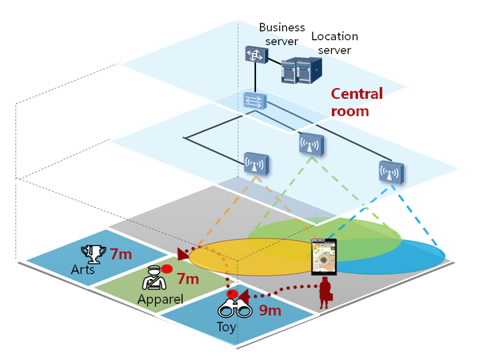Additional functions provided by Location Based Service (LBS)
The underlying mechanism of LBS

An indoor WIFI location is implemented via Received Signal Strength Indication (RSSI) of different wireless Access Points (APs). It mainly consists of five parts, namely Real Time Location Server (RTLS Server), RTLS business application server, wireless Access Control (AC), wireless APs, mobile terminals.
The functions supported by LBS
1. Store navigation
A buyer can locate a particular store and find the route to there with his mobile phone.
- The RTLS sever stores a map of the mall, and synchronizes with the application server.
- The first time a customer’s phone is logged into the mall wireless network, the mall map is automatically downloaded to the phone by AppS software installed on the phone. Afterwards updates may apply to remain the most recent version.
- A customer first finds out the location of the store by using the search function of the AppS, then taps “how to arrive” button to get the shortest path to the store.
- The application server refreshes the position of the mobile phone holder every 5 seconds, and checks whether the customer has deviated from the given route. If so, it will recalculate and send the updated route to the phone.
2. Locating parked cars
By using the LBS, such a process becomes much easier.
- After the car is parked, the customer can record its position with only a tap on the mobile phone connected to the RTLS server via the wireless network installed in the lot.
- Back at the lot, the customer can use that recorded position to find the parked car. The LBS can guide him there.
3. Target marketing
There are two marketing modes in malls: active and passive. Passive marketing occurs when a user can search marketing information of the mall with AppS. With active mode, the LBS can push promotional information from nearby stores to the mobile phone of the user. The active mode is proven to be more accurate and effective.
The value added service provided in this solution can significantly improve the shopping experience and marketing efficiency, thus attracting more customers and lowering operational cost for retailers.
Saving customer time and efforts
Customers can find the particular stores or their parked cars in lots and get there by use of LBS with much less effort, resulting in improved customer experience.
Increasing marketing efficiency
By replacing the hand delivery of leaflet with targeted direct wireless marketing, a mall can significantly lower marketing cost while boosting its efficiency.
No need for on-site measurement
By using Huawei WLAN deployment tools, there is no need for on-site measurement of wireless field intensity. The Huawei WLAN deployment tool can realize automatic AP deployment design offering evenly distributed wireless signal strength in a mall, which meets LBS requirements.

